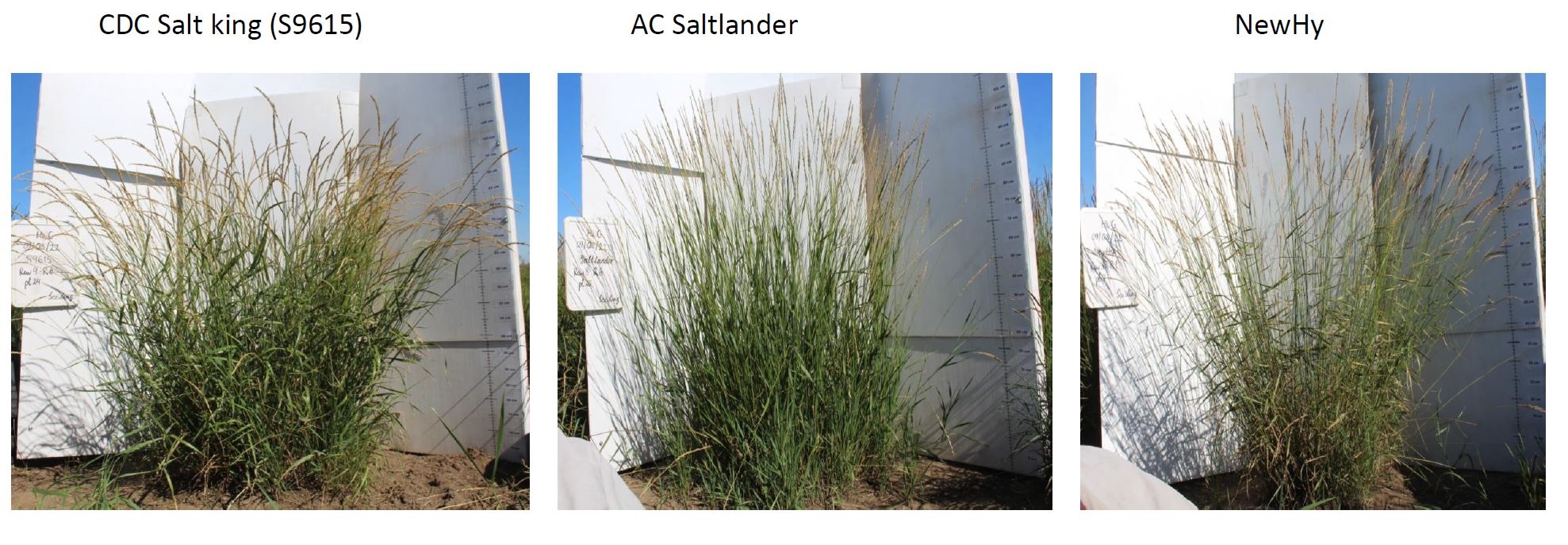CDC Salt King
| Denomination: | 'CDC Salt King' |
|---|---|
| Previously Proposed Denomination: | 'S9615' |
| Botanical Name: | Elymus repens x Pseudoroegneria spicata |
| Applicant/Holder: |
University of Saskatchewan Crop Development Centre 4D36 Agriculture Building, 51 Campus Drive Saskatoon, Saskatchewan S7N 5A8 Canada |
| Breeder: |
Bill Biligetu, University of Saskatchewan, Saskatoon, Saskatchewan |
| Application Date: | 2022-05-20 |
| Provisional Protection:: | 2022-05-20 |
| Application Number: | 22-10931 |
Variety Description
Varieties used for comparison: 'AC Saltlander' and 'NewHy'
Summary: The flag leaf of 'CDC Salt King' is narrower than that of 'AC Saltlander' and wider than that of 'NewHy'.
Description:
SEEDLING: pubescence on leaf sheath present at 5 to 9 tiller stage
PLANT: perennial type, hexaploid, semi-erect growth habit at 9 or more tiller stage, rhizome present, inflorescence emerges mid-season, semi-erect growth habit in autumn of year of sowing, matures mid-season
LEAF: medium green leaf colour at 9 or more tiller stage
FLAG LEAF: long, narrow
STEM: long
INFLORESCENCE: long, lax
AGRONOMIC TRAIT: good winter hardiness
Origin & Breeding History: 'CDC Salt King' (experimental designation S9615) originated from a nursery of hybrid wheatgrass established in 2009 in Saskatoon, Saskatchewan with the variety 'AC Saltlander' and introductions from the United States Department of Agriculture genebank (Accession number PI 631392, PI 546061 and PI 538763). After 2 years of evaluation for plant vigor, height, growth habit and freedom from disease, 25 plants were selected as a population and designated as synthetic generation S9579. From 2012 and 2014, further selections of S9579 were based on plant vigor and seed yield through recurrent mass selection to develop populations designated as synthetic populations S9600 and S9604. From 2014 to 2017, plant selections from these 3 populations were based on total tiller number, number of reproductive tillers, seeds per tiller and growth habit. Seedlings screened for salt tolerance were transplanted to field nurseries and diseased plants removed. In 2018, S9615, a 30-clone synthetic population, was developed by mass selection of desirable plants from populations S9579 (36%), S9600 (26%) and S9604 (38%). Breeder seed production from an isolated field plot commenced in 2021.
Tests & Trials: The comparative trials for 'CDC Salt King' were conducted at the University of Saskatchewan's Livestock Forage Centre of Excellence, in Clavet, Saskatchewan during the 2021 and 2022 growing seasons. There were 6 replications per variety arranged in an RCB design. Plots consisted of a three 30 metre rows with 15 plants of each variety with an inter-row spacing of 1 metre. Measured characteristics were based on 65 measurements per variety per year. Mean differences were significant at the 5% probability level based on t-tests using least square means value.
Comparison table for 'CDC Salt King' with reference varieties 'AC Saltlander' and 'NewHy'
Flag leaf width (mm)
| 'CDC Salt King' | 'AC Saltlander' | 'NewHy' | |
|---|---|---|---|
| mean 2021 | 6.2 | 6.7 | 5.8 |
| std. deviation 2021 | 0.85 | 0.84 | 0.76 |
| mean 2022 | 6.7 | 7.0 | 6.4 |
| std. deviation 2022 | 0.85 | 0.70 | 0.72 |
Click on image for larger view

Hybrid Wheatgrass: 'CDC Salt King' (left) with reference varieties 'AC Saltlander' (centre) and 'NewHy' (right)
Click on image for larger view

Hybrid Wheatgrass: 'CDC Salt King' (left) with reference varieties 'AC Saltlander' (centre) and 'NewHy' (right)
Click on image for larger view

Hybrid Wheatgrass: 'CDC Salt King' (left) with reference varieties 'AC Saltlander' (centre) and 'NewHy' (right)
- Date modified: